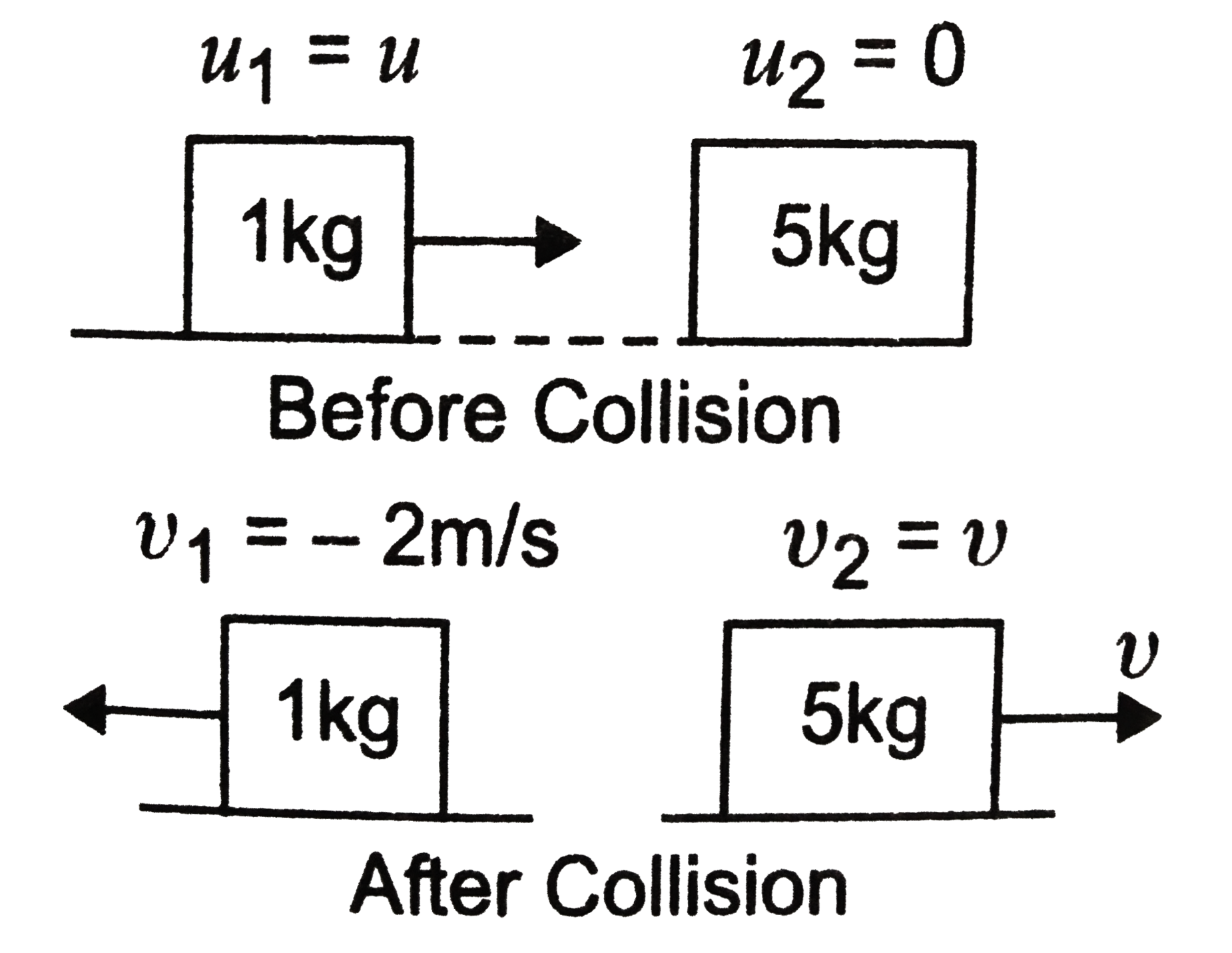A point mass of 1kg collides elastically with a stationary point mass of 5 kg. After their collision, the 1kg mass reverses its direction and moves with a speed of 2ms−1. Which of the following statements (s) is (are) correct for the system of these two masses?
Total momentum of the system is 3kgms−1
Momentum of 5kg mass after collision is 4kgms−1
Kinetic energy of the centre of mass is 0.75J
Total kinetic energy of the system is 4J
The correct Answer is:A, C
Total momentum before collision
=m1u1+m2u2=1×u+5×0=u
Total momentum after collision
=m1υ1+m2υ2=1×(−2)=5×υ
=5υ−2
According to law of conservation of linear momentum
u=5υ−2...(i)
Accroding to law of conservation of K.E.
12m1u21+12m2u22=12m1υ21+12m2υ22
or 12×1×u2+12×5×0=12×1×(−2)2+12×5υ2
or u2=4+5υ2...(ii)
Solving (i) and (ii), we get υ=1m/s
and u=3m/s
Total momentum of the system before collision
=3kgm/s.
Momentum of 5kg mass after collision =m2υ2
=5×1=5kgms−1
Now,υcm=m1υ1+m2υ2m1+m2
=1(−2)+5(1)1+5=12m/s
K.E. of c.m=12(m1+m2)υ2cm
=12(1+5)(12)2=0.75J
Total K.E. of the system =12m1υ21+12m2υ22
=12×1×(−2)2+12×5×12=2+2.5=4.5J.

Topper's Solved these Questions
- BOOK - PRADEEPCHAPTER - WORK, ENERGY AND POWEREXERCISE - Fill in the blanks10videos
WORK, ENERGY AND POWER
- BOOK - PRADEEPCHAPTER - WORK, ENERGY AND POWEREXERCISE - Problems For Practice76videos
WORK, ENERGY AND POWER
- BOOK - PRADEEPCHAPTER - WORK, ENERGY AND POWEREXERCISE - value Based Question5videos
WORK, ENERGY AND POWER
- BOOK - PRADEEPCHAPTER - THERMODYNAMICSEXERCISE - Assertion- Reason Type Questions19videos
THERMODYNAMICS
Similar Questions
A ball of mass 2 kg moving with 4 m/s collides elastically with a stationary ball. If it continues to move in original direction with 1/4th of its original velocity. Find velocity of centre of mass of system
View SolutionA 5kg mass collides with a body at rest. After the collision, they travel together with a velocity one third the velocity of 5kg mass. The mass of the second body is
View Solution
Knowledge Check
- Question 1 - Select One or More
A point mass of 1 kg collides elastically with a stationary point mass of 5 kg. After their collision, the 1 kg mass reverses its direction and moves with a speed of 2 m/s. Which of the following statements are correct for the system of these two masses?
ATotal momentum of the system is 3 kg m/s.BMomentum of 5 kg mass after collision is 4 kg m/s.CKinetic energy of the center of mass is 0.75 J.DTotal kinetic energy of the system is 4 J. - Question 2 - Select One
A 6kg mass travelling at 2.5ms−1 collides head on with a stationary 4kg mass. After the collision the 6kg mass travels in its original direction with a speed of 1ms−1. The final velocity of 4kg mass is
A1ms−1B2.25ms−1C2ms−1D0ms−1 - Question 3 - Select One
A mass of 20 kg moving with a speed of 10 m / s collides with another stationary mass of . 5kg As a result of the collision, the two masses stick together. The kinetic energy of the composite mass will be
A600 JouleB800 jouleC1000 jouleD1200 joule
A truck of mass 1000 kg moving with a speed of 72 km/hr collides with a stationary truck of the same mass . After the collision , the trucks get stick together and move . Calculate their common speed after collision . Is it elastic or ineleastic collision ?
View SolutionA mass of 20 kg moving with a speed of 10 m / s collides with another stationary mass of . 5kg As a result of the collision, the two masses stick together. The kinetic energy of the composite mass will be
View SolutionA ball of mass 5 kg moving with speed 8 m/s collides head on with another stationary ball of mass 15 kg. If collision is perfecty inelastic, then loss in kinetic energy is
View SolutionA ball of mass 5 kg moving with speed 8 m/s collides head on with another stationary ball of mass 15 kg. If collision is perfectly inelastic, then loss in kinetic energ is
View SolutionA ball of mass 1 kg moving with a velocity of 0.4 ms−1 collides with another stationary ball. After the collision, the first ball moves with a velocity of 0.3ms1 in a direction making an angle of 90∘ with its initial direction. The momentum of the second ball after the collision will be (in kg ms−1)
View Solution

